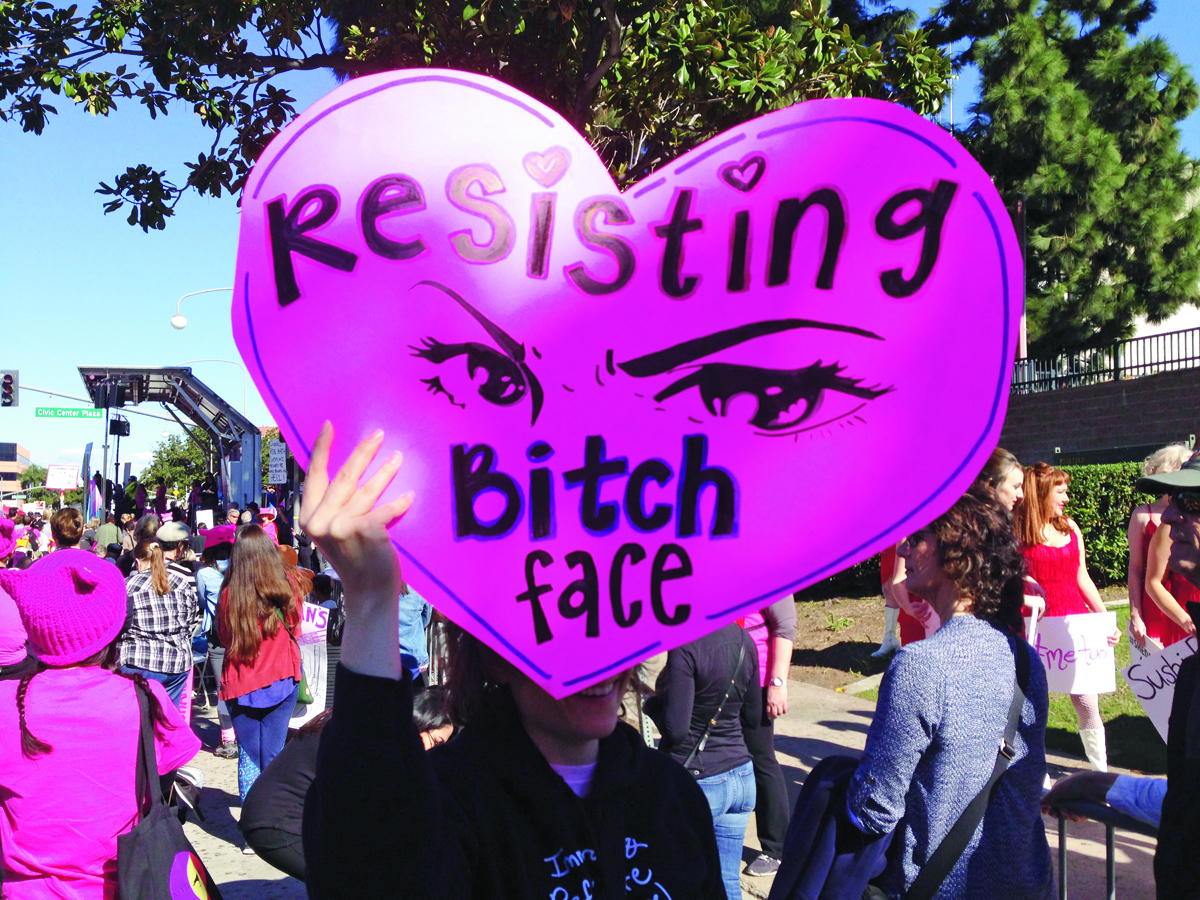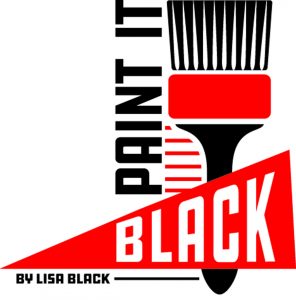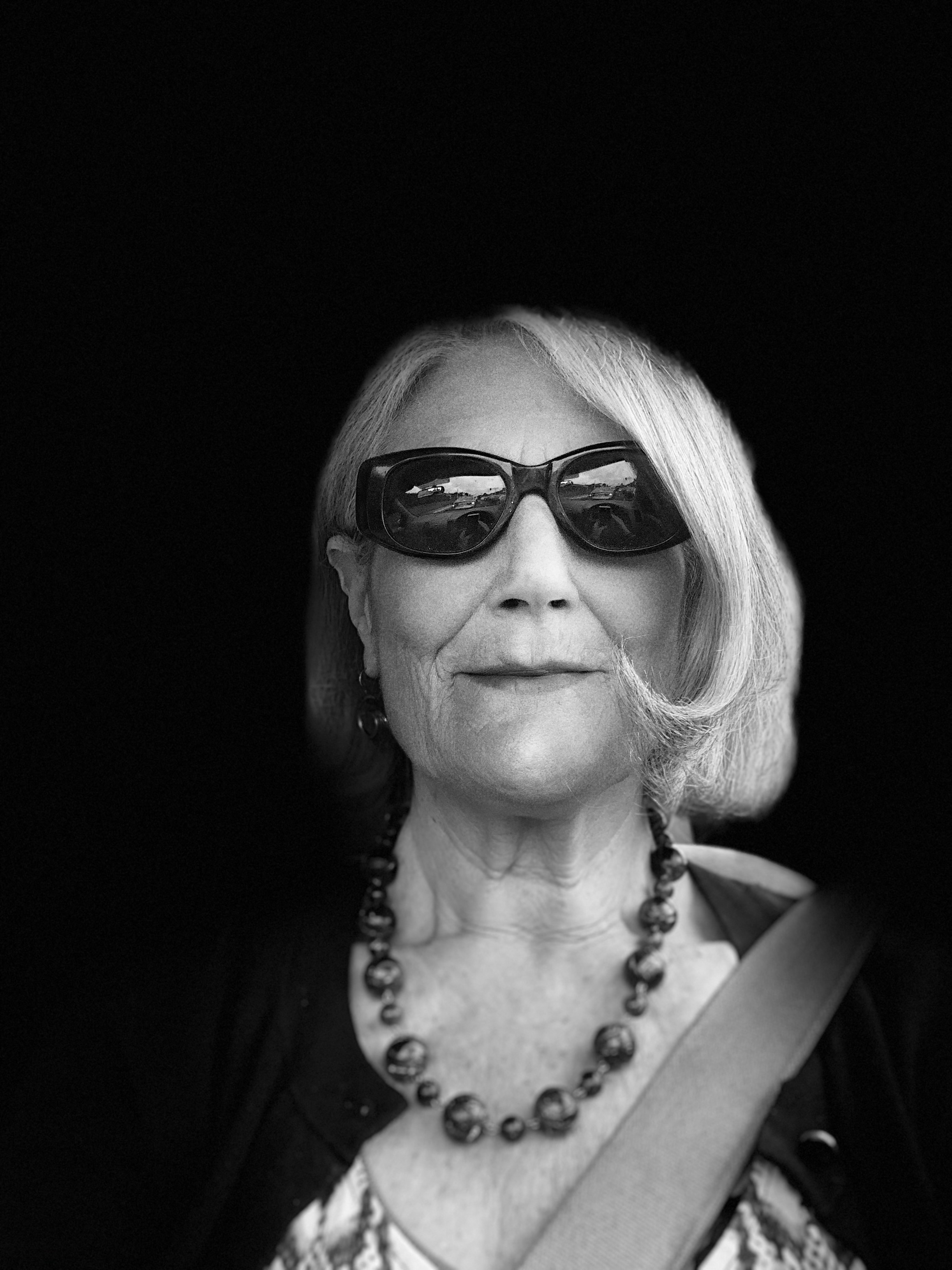
New Year’s Eve no longer divides one year from another for Paint It Black. Since the 2016 election, the Women’s March on Washington and its worldwide sister marches signal another trip around the sun. I’ve got my Resisting Bitch Face on, and I’m ready to look back (and forward) from march to march.
On an elemental level, that first massive protest denotes fire. As I stood on a grassy knoll rising above jam-packed Calle Cuarto in Santa Ana the day after 45’s inauguration, I had hoped the hand-lettered sign I photographed would become a prophesy: “The plan is to fan this spark into a FLAME.”
Beneath the horrors that rolled out relentlessly over the next year, resistance burned. Organizers set to work. Many of the millions of women and men who’d marched that day committed to run for office. I still wonder if the veterinarian who told me over a high-ABV ale at Recess afterward that she was considering a bid followed through with her plan.
The second Santa Ana march early this year was bigger and better. That night, while looking at slideshows from protests around the world, I saw a sign in South Asia that read, “Resistance is Fertile.” I swiped the slogan for the Weekly’s coverage headline. And if you want something to grow, you better water it, right? Water, I declare, is 2018’s element.
If magenta yarn sold out across the land leading up to the first march, then it was blue tempera paint for the second. The signage went from black-and-red marker on rectangles to an explosion of color and shapes beyond the confines of poster board. Not only were cresting tidal waves depicted, but other savage signage was legion in the form of turds and (im)peaches, as well. Protesters’ fiery fears had been cooled; joy and humor burst out as people admired the riot of creativity and snark.
The OC coalition of 25 organizations did a spectacular job preparing, from the practical to the aspirational. The rallies before and after exemplified inclusivity; particularly powerful for me was the onstage presence of Native American speakers, women from Black Lives Matter Long Beach, and girls from several local high schools.
Each speech and every step along the route had a subtext: “Grab ’em by the midterms.”
Ten months later, 35 newly elected women will be sworn into the U.S. House of Representatives. Come Jan. 3, 2019, the total number of women in that legislative body will reach nearly 20 percent. Wow, we are getting so close to matching the actual female population of 51 percent!
But among those 35 women are many firsts: the first Muslim American, first Native Americans, first African American from New England—and the first time all seven OC districts are blue. Okay, that last one has men, too, many of whom also marched.
So I’m declaring the midterms neither a blue wave nor a women’s wave, but rather a short ride toward equal representation.
Before projecting which of the two remaining elements will characterize the upcoming Women’s March (note there’s no trademark attached to the term), let me say that waves and water flowed through many of the South County cultural happenings that appeared in Paint It Black this year.
Elizabeth Turk’s Shoreline Project brought a thousand volunteers to animate curated umbrellas that glowed in the dusk on Laguna’s Main Beach. It was a massive community celebration with an underlying message to slow down the disappearing shores. Filmmaker Elizabeth Pepin Silva’s La Maestra, about the first local woman to surf the remote Baja break near her village, screened outdoors at the San Onofre Parks Foundation, along with a talk by professor Krista Comer on her book Surfer Girls In the New World Order.
Casa Romantica exhibited three extraordinary Baja artists whose seascapes, magical-realism rain and bronze vessels floated down imaginary waterways. Surfing Heritage and Culture Center added to the full story of surfing by featuring four women in its summer exhibit, plus honoring them at its annual gala.
And while it had nothing to do with liquid, Casa Romantica’s international exhibition of Rwandan artist Emmanuel Nkuranga was an object lesson in resilience. The co-founder of Inema Cultural Center in Kigali brought a spectacular optimism to his energetic, vivid, paint-carved works. That such a dynamo could thrive barely two decades after his country was severed by civil war and a staggering genocide models a turnaround that imbues hope we’ll recover from our own blatant nationalism.
Speaking of the windbag blowing from Washington, D.C., the element that best fits the third women’s march is, in all subjectivity, air—as in airing the swamp-dirty laundry from collusion to corruption in the campaign, the transition, the inauguration and the administration. But mostly it’s for the breath of fresh air, elected mostly PAC-fund-free, that takes over the House. Those men and women will, as they’ve done throughout their orientation, give the human rights we’ve been demonstrating about a voice in the government.

But there has been some ill wind surrounding the Women’s March itself.
Recently, Orange County Women’s March organizers released a statement on social media declaring financial, leadership and decision-making independence from the founders’ Women’s March Inc. My first reaction was panic and the now-ubiquitous fear of troll farms: There goes the unity! The mass participation!
I reached out and learned the OC march has been independent all along. “We spent a lot of time discussing the issues that have come up within the national [Women’s March Inc.] and agreed it was important this year to make a statement about our independence. . . . It was not an easy decision.”
The now-30-member coalition’s declaration reads, in part: “The Orange County Women’s March stands against hate in all forms. We denounce any statements against the Jewish and LGBTQIA+ communities and will continue to take action to promote intersectionality and equity as we work toward our vision of restoring dignity, sharing humanity, and promoting inclusivity and justice for all.”
As I learned from Comer’s Surfer Girls, that which is local is also global. The way we protect, sustain and interact at our local break (or march) is not only unique, but also shares a structural commonality with surf spots (marches) everywhere in the world.
So we’ll organize locally but march in Santa Ana and LA and the world over for women’s/human rights on Jan. 19, 2019.
Then I guess we’ll truly start saving the Earth in 2020.

Lisa Black proofreads the dead-tree edition of the Weekly, and writes culture stories for her column Paint It Black.


One Reply to “Earth, Wind, Fire and Water: How the Elements Play Out In the Women’s Marches”